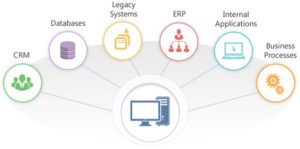
IT integration strategy: 7 best practices
In a world ruled by technology, companies need systems and apps that are seamlessly integrated.
These are 7 best practices for every IT integration strategy.
Every company can benefit from a diverse, multicultural team, where people with different backgrounds, languages, and cultures work together to innovate and create great products. When it comes to IT systems, however, the opposite is true. The lack of diversity is the competitive edge, and a shared “language” goes a long way in creating a productive and seamless workflow. This is what an IT integration strategy is, why having one is important for companies of all sizes, and how to implement it. What you’ll learn:
- What is an IT integration strategy?
- What are the advantages of an IT integration strategy?
- IT integration strategy: 7 best practices
- Need some help from an IT integration expert?
What is an IT integration strategy?
On average, small businesses use 22 software applications for all kinds of purposes. This number goes up to 788 for large enterprises with more than 50,000 employees. These should be integrated to work properly, which is one of the biggest challenges for IT departments. So much so, that by 2024 around 65% of organizations will consider spending on integration capabilities as strategic investments.
It is easy to see why. As the volume of data increases, companies face new challenges in management, particularly in the way systems transfer information between each other. Think Enterprise Resource Planning (ERP), Customer Relationship Management (CRM), and Supply Chain Management (SCM) software. Not to mention data warehouses or data lakes, business intelligence (BI) platforms, and enterprise social networking (ESN) platforms. Sowing together all the information these systems generate is a big challenge, even for savvy IT managers.

What is IT integration? Source: CareIT
An IT integration strategy is, essentially, a plan for how these different IT systems will be made to work together – in other words, “talk” to each other. This way, when a new order arrives, a warehouse picking list can be automatically updated, and a replenishment order issued without human intervention. And every time a machine breaks down, maintenance schedules can be updated, and spare parts ordered.
Doing so can involve anything from choosing compatible software and hardware to developing custom interfaces between systems, to training staff on how to use the new system. In its essence, an IT integration strategy is a roadmap for how an organization will bring together disparate systems and data sources into a cohesive whole. The strategy should detail the goals of the integration, the specific systems, and data sources to be integrated, the budget and resources available, the methods and technologies to be used, and the timeline for completion.
An effective IT integration strategy will consider the needs of all stakeholders, including users, IT staff, and senior management. With all these factors in mind, a successful IT integration can bring significant benefits to an organization, including increased efficiency, better data management, and enhanced collaboration. And these are just some of its key advantages.
What are the advantages of an IT integration strategy?
Implementing an IT integration strategy has significant benefits for companies of every size, from cost savings to increased security.
Cost savings
By consolidating and standardizing disparate IT systems, an organization can reduce the overall number of systems it needs to maintain and support. This can lead to reduced hardware, software, and support staff costs. In addition, an effective IT integration strategy can help an organization reduce duplicate data storage and processing, which can also lead to cost savings. Finally, it can help an organization improve its overall operational efficiency, which can lead to reduced costs associated with inefficiencies. Manual, repetitive tasks needed to adapt to each system’s needs are eliminated and made less prone to mistakes. Time usually spent on non-value-added tasks is put to better use elsewhere.
Improved end-to-end colab
Implementing an IT integration strategy also brings processes closer and facilitates collaboration and communication. It brings down silos, streamlines processes, and reduces human error. It provides businesses with an end-to-end performance analysis of vital processes. With integrated processes and systems, from sourcing to delivery, it is possible to get transversal data and set common goals. Contrary to what happens when each team works towards its own goals, the IT integration strategy centralizes communication and process automation between the various departments, which unifies goals and increases productivity.
Additional security
Crucially, an IT strategy can contribute to improved security. By integrating disparate systems, organizations can reduce the number of potential attack surfaces and make it more difficult for attackers to move laterally within the network. In addition, IT integration can improve visibility into network activity and allow for more effective detection and response to security incidents. By sharing information and coordinating responses across different IT systems, organizations can more effectively defend against cyber threats. Finally, IT integration can help reduce the overall cost of cybersecurity by eliminating duplicate efforts and improving efficiency.
IT integration strategy: 7 best practices
For digital transformation to be a success, there are several best practices to follow. There are the main ones.
1. Set clear objectives
There are a few key performance indicators (KPIs) that are important to consider when developing an IT integration strategy, such as the time and cost to complete the integration process. Another important metric is the number of applications that need to be integrated. This will help determine the complexity of the project and the amount of testing that will be required. Finally, the level of data consistency is also a key metric. This will help determine how much data cleansing will be required and how many data discrepancies can be tolerated.
2. Define the scope
Define which processes and systems will be integrated and prioritized. For instance, if lead management, invoicing and stock management software are frequently used together, then these are likely candidates for integration. Also, critical systems where mistakes or delays can represent significant costs can be prioritized. The same goes for those processes where current “integration” requires hefty human intervention. Set clear criteria for which systems need to be integrated sooner rather than later and set the scope for the IT integration project.
3. Don’t be afraid to review underlying processes
Before kicking off any IT integration efforts, confirm whether the underlying process is optimized or needs improvement. Automating wasteful steps is a form of waste that will propagate inefficiencies across the organization. Say your current sign-in process requires more information than it needs to or more validation steps than necessary. Passing that information onward will lead to excessive use of data storage and increase development time. Carefully review the processes before setting the IT integration project in motion.
4. Integrate comms
Scattered communications can thwart even the most well-thought-out IT integration plans. Define which channels are to be used and for which type of information (such as Slack for IMs, emails to summarize next steps and agreements, and so on). With the right and optimized communication channels, employees will be able to interact, clarify doubts, find solutions together, improve customer service and share information – all in an agile, centralized, effective, and productive way.
5. Make it flexible
IT integration is an ongoing endeavour that requires flexibility to grow and adapt. Ensure that the IT integration strategy is accessible to all company employees, regardless of their level of familiarity with information technologies. Consider no-code tools to democratize integration. In this way, any user will be able to update and create integrations to reduce dependence on specialized and dedicated employees.
6. Bring people together
By definition, IT integration projects require different viewpoints from people in different areas of the company. So, if you are working to integrate sales and stock management, representatives from both areas (not just IT) such weigh in. In this way, professionals will feel more motivated to act and decide together, identifying breakdowns and seeking solutions that are best for the company.
7. Evaluate results
The integration of IT operations makes it possible to obtain performance indicators, which are decisive for monitoring the operational and financial health of the company. So, define which metrics best translate your business goals and follow them up closely and periodically. In this way, it will be possible to identify areas that need improvement and those that are performing well.
Need some help from an IT integration expert?
IT integration is a path to the future. A future where manual tasks, information silos, and isolated systems are a thing of the past. However, all innovative technologies have some known pitfalls you should avoid at the organizational, technical, and process levels. To stay away from these common mistakes, look for a partner to guide you in the right direction. Luckily, at Near Partner we are problem solvers and IT integration experts, and we’re keen to help you with your digitalization journey.
There is no project too big for our superstar developers. Get in touch and let’s create something together!




